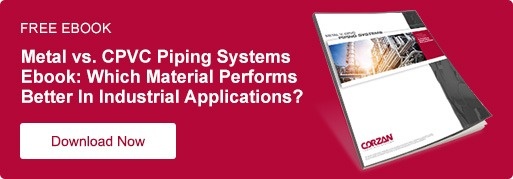Why CPVC Piping is More Energy-Efficient Than Metal Piping
Minimizing energy costs is one of the main areas of opportunity for plant owners looking to increase their bottom-line.
At a macro level, according to the U.S. Energy Information Administration (EIA), the industrial sector uses more energy than any other sector, consuming about 54% of the world’s total delivered energy.
Engineers are always looking for ways to optimize system processes to improve energy efficiency to decrease energy expenses. Proper piping material selection is one opportunity to limit energy consumption.
Take a look at how CPVC piping compares to metal piping in terms of energy efficiency across a system’s lifecycle, even before the pipe is installed.
Benefits of CPVC Transportation
Before installation is complete and the system begins processing, energy consumption advantages are already recognized with CPVC.
Less Fuel Consumption During Transportation and Delivery
There is a significant weight difference between CPVC and steel piping. A six-inch schedule 80 piece of Corzan CPVC weighs about six pounds per foot. The equivalent in steel weighs between 25 and 29 pounds per foot—six times as much.
In terms of energy consumption, delivery trucks and other transportation vehicles must work six times harder to move steel piping from location to location. According the U.S. Department of Energy, for each 100 additional pounds of weight, fuel consumption increases by 1-2%. When the difference in weight can be thousands of pounds, the cost advantage is significant.
CPVC Systems Operate at a Higher Level of Efficiency
Greater efficiency of CPVC systems does not end at installation, but is recognized throughout the system’s lifecycle.
CPVC Thermal Conductivity Increases Energy Efficiency
Engineers assess the heat conductivity of piping through an R-value—a measure of how well an object, per unit of its exposed area, resists the conductive flow of heat. For example, a piping material with lower thermal conductivity will maintain a lower surface temperature when transporting hot fluids.
CPVC is much less conductive than metal, with an R-value and heat transfer coefficient about 1/300th that of steel. This means the rate of heat transfer through CPVC is typically 50-60% less.
In low temperature environments, metal piping requires costly insulation to keep fluids warm. In the hot sun or in hot environments, it heats the external pipe and transfers that heat inwards, heating the processing fluids significantly. This translates to chillers and/or heaters working longer and harder just to maintain fluid temperature.
In short, CPVC better maintains the desired temperature of whatever is being processed.
CPVC Is Less Prone to Pressure Loss
The pressure loss of a system is a factor of the pipe’s diameter and smoothness of its inner walls. Larger pipes with rougher walls suffer from pressure loss, requiring stronger pumps and more energy output. Smaller pipes with smooth walls are better at maintaining pressure with less effort.
The measure of a material’s smoothness is its Hazen Williams C-Factor—the higher the value, the smoother the pipe material.
For comparison, new cast iron pipe has a C-Factor of 120 upon installation, but can drop to 60 or 70 during its working life. Corzan CPVC, however, has a C-Factor of 150 at installation and maintains that throughout its lifecycle. Because CPVC piping is less susceptible to corrosion, it can carry streams continuously and preserve smooth walls—even if those streams contain harsh chemicals.
Metal systems suffer from corrosion, creating a rougher surface that applies more friction to the fluid. Scaling, another key concern, will build up on the pipe’s interior creating uneven surfaces and constricting the pipe diameter. Each of these issues requires greater energy output from pumps.

Metal piping (left) compared to CPVC piping (right) after years of service.
The inherent smoothness of CPVC when compared to metal, as well as its ability to resist corrosion and scaling over time can translate to smaller pumps that require less energy.
To determine if your process is compatible with CPVC, view the Corzan CPVC Chemical Resistance table, which analyzes Corzan CPVC’s resistance to more than 400 chemicals and compounds.
CPVC is the Energy Efficient Piping Option
All factors considered, CPVC is preferable for those looking to optimize energy consumption and meet or exceed environmental standards.
To learn how CPVC and metal piping compares in categories other than energy efficiency, view our ebook—Metal v. CPVC Piping Systems: Which Piping Material Performs Better in Industrial Applications.


